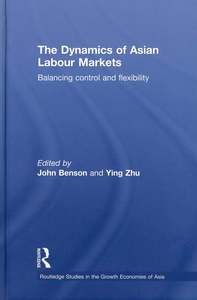Labour markets in Singapore: flexibility in adversity
Leggett, Chris (2011) Labour markets in Singapore: flexibility in adversity. In: Benson, John, and Zhu, Ying, (eds.) The dynamics of Asian Labour Markets: balancing control and flexibility. Routledge Studies in the Growth Economies of Asia, 102 . Routledge, Milton Park, UK, pp. 83-106.
![[img]](https://researchonline.jcu.edu.au/16506/2.hassmallThumbnailVersion/16506_Leggett_2011_Book_Cover_.jpg)
|
Image (JPEG) (Published Version)
- Published Version
Download (226kB) |
|
|
PDF (Published Version)
- Published Version
Restricted to Repository staff only |
Abstract
[Extract] When Singapore seceded from the Malaysian Federation in 1968, the fonner British colony - an island entrepot covering just 682.7 square kilometres of land at the southern tip of the Malay Peninsula - had few assets other than its human resources, the resolve of its political leaders, and the advice of a fonner UN economist. 1 Despite the paucity of its resources, Singapore has built a highly successful economy over the course of its short history.
Singapore embraced globalization in the early 1960s when the People's Action Party (PAP) government committed the city-state to industrialization, largely funded by multinational investment in export-oriented manufacturing. Its rapid industrialization was complemented by infrastructure building, both social and physical. In the late 1970s, the government began to induce the transformation of the low technology, labour intensive economy into one based on high technology and high value-added enterprise.
The management of its labour market is one ofthe keys to Singapore's economic success. As Coe and Kelly (2000: 414) note, 'There can be few other places in the world where the social regulation of the labour market has been so consistently and explicitly a central component of national development strategy as it has been in Singapore'. This chapter elaborates the governance of Singapore's socially and politically constructed labour market (See Gospel, Chapter 2 this volmne).
Sustained economic growth led to a labour shortage by the late 1970s. The tight labour market was eased by importing foreign workers, and in the 1980s a programme to upgrade the skills of Singapore workers further improved the capacity of the labour market to supply the needs of industry. By the beginning of the twenty-first century, Singapore was developing its workforce to meet the country's aspiration to become a world talent capital. The government increased institutional efficiency in the management of human resources, enabling Singapore to adjust to and recover from several economic crises, most induced by downturns in the world economy, to which the country's global status makes it vulnerable. The adverse effects of economic crises on the local labour market were short-lived and cushioned by the retrenchment offoreign workers, consistent with the government's emphasis on employment growth rather than protection.
| Item ID: | 16506 |
|---|---|
| Item Type: | Book Chapter (Research - B1) |
| ISBN: | 978-0-415-55111-3 |
| Keywords: | labour markets, Singapore, flexibility, control, foreign workers |
| Date Deposited: | 28 Jul 2011 06:18 |
| FoR Codes: | 14 ECONOMICS > 1402 Applied Economics > 140211 Labour Economics @ 100% |
| SEO Codes: | 91 ECONOMIC FRAMEWORK > 9199 Other Economic Framework > 919999 Economic Framework not elsewhere classified @ 100% |
| Downloads: |
Total: 436 Last 12 Months: 4 |
| More Statistics |



